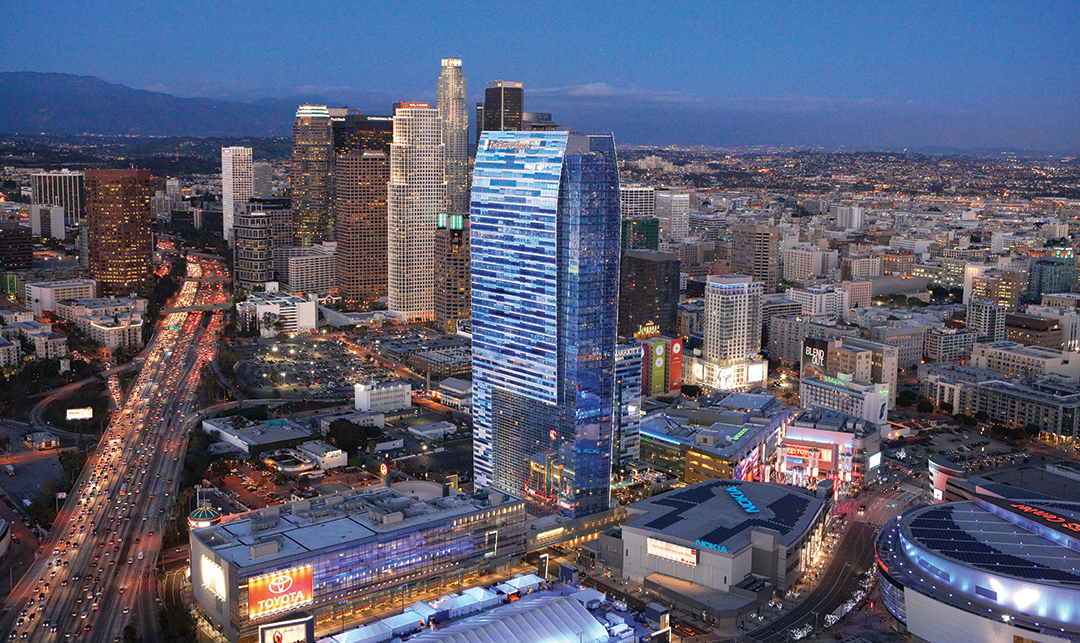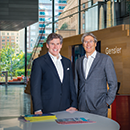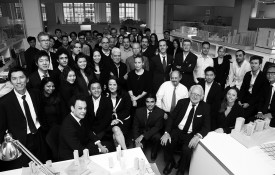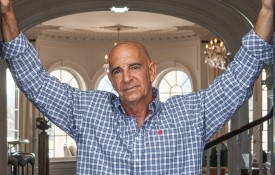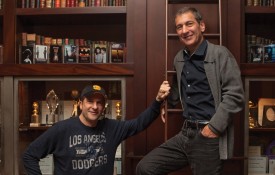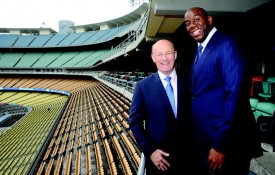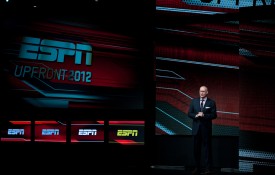When driving past Downtown Los Angeles on the 110 or 10 Freeways, it is nearly impossible to ignore the Ritz-Carlton Hotel & Residences and JW Marriott that stand 55 stories above the city’s L.A. Live–STAPLES Center entertainment complex. The tower’s façade appears to be sea glass that Pacific Ocean waves took decades to weather into blue hues. With its smooth, angular shape, reminiscent of a surfboard, it is a quintessential Los Angeles building. Children and adults alike look at it and marvel, “Wow, that’s cool.”
More than just cool, its architectural design reveals what is happening inside. As its shape expands and the ascending glass changes colors, the building’s inhabitants switch from JW Marriott guests to Ritz-Carlton Downtown Los Angeles (DTLA) guests and residents – residents being afforded the luxury of rooms that are five feet deeper and views that expand from the San Bernardino Mountains to the ocean. That it is a mixed-use structure is a new characteristic of Downtown’s buildings and of urban architecture overall.
“We are constantly pushing the envelope on design innovation, focusing on performance-based design that is all about the user experience,” says Andy Cohen, one of Gensler’s three co-CEOs. Cohen joined the firm in 1980, and for the past 10 years has shared top leadership duties with David Gensler (who is based in San Francisco) and Diane Hoskins (in Washington, D.C.).
“The key is how we use the power of design to make a better world,” adds Robert Jernigan, regional managing principal at Gensler. “There should be more substance behind design than ‘it looks cool.’” The firm’s DTLA office is an example of “substance behind design” and serves to showcase the firm’s belief that the best office cultures provide areas that support four different work modes: focus, collaboration, learning, and socialization. “LA, as a city, was once the world’s largest office park – people came to work and [after work] people left [the city],” says Jernigan. “You’re going to start to see that buildings over 50 stories are no longer mono-functional and are generally mixed use.”
The building in which Gensler is housed is a case in point. The firm moved to DTLA from Santa Monica in 2011, into the street-level floor of the 52-floor City National Plaza. Gensler’s space once housed a retail bank, occupying 50,000 square feet and two floors, the top level used for storage. A tour of the office today reveals the only evidence of the former bank is the structure’s granite core. Inside, Gensler cut a hole in the roof and installed an expansive skylight, then suspended a third floor from hangers and built stairs that spill out onto the first-floor amphitheater that is regularly used for a speaker series that is open to the community.
In Los Angeles, the Gensler footprint is deep and expansive: Besides the JW Marriott-Ritz Carlton, the firm’s projects include Creative Artist Agency’s headquarters in Century City, midfield terminal at LAX, the Los Angeles Football Club and AltaSea, an innovative ocean sustainability, business, research, and education hub at the Port of Los Angeles.
Globally, Gensler is “working in Europe, the Middle East, Asia, India, and Africa,” says Cohen, who among the firm’s CEO troika serves as its global guru, “handling global client relationships and design innovation.”

Andy Cohen (right) and Rob Jernigan (left) have more than four decades of combined experience at Gensler
United Leadership and Far-Reaching Influence
Cohen has biweekly video conference calls with co-CEOs Gensler and Hoskins, and the three also meet when the firm holds its 10 annual global leadership meetings at various international locations. Gensler is responsible for business and finance, and Hoskins is responsible for talent and practice-area strategies.
The troika has led Gensler since 2005, and over the past decade the firm has expanded to the point where it is now “the largest architectural firm in the world,” according to Cohen. “In 2005, we had probably 20 offices and 2,000 people, and now we have 46 offices and 5,000 people. Revenue wise, we had $200 million [in 2005] and now … we are going to do $1.1 billion in revenue [in 2015] … last year we worked in over 70 countries around the world. It’s been an incredible run.”
The firm’s growth is largely due to its growing global footprint that reveals an entrepreneurial corporate culture rooted in Co-founder Arthur Gensler’s philosophy of a family-supportive work environment that permits employees to be entrepreneurial, culturally competent, and hold client needs in the highest regard. An example of the results of that philosophy working is Gensler’s success in China. In 2007 the firm was in a global competition to win the rights to design China’s Shanghai Tower, which upon completion will be the second tallest building in the world at 2,073 feet.
“It’s an icon/symbol for Chinese culture and prosperity,” says Cohen of the country that has surpassed the U.S. in the number of high-rise towers it has built in the past 20 years.
At the same time a Gensler employee, Jun Xia, a Chinese national who was U.S.-educated and worked in Gensler’s Denver office, had been asking if he could move back to China. Xia was a gifted architect in the Denver office, but rather than keep him there, Gensler enlisted him to open an office in Shanghai and demonstrate to the Chinese government that the firm was willing to become a partner.
Typically architecture firms are viewed as carpetbaggers, says Jernigan. They do not open permanent offices in countries in which they do business, but instead bring their designs to their home office. Gensler’s modus operandi is to follow its clients and open offices where its clients need the firm’s services.
“I think the Chinese government really appreciated that we were committed to China, committed to growing that office, training their people and making their people part of our organization,” says Jernigan. “It’s that whole notion of ‘teach a man to fish’ versus ‘give a man a fish.’”
Under Xia’s leadership, Gensler’s Shanghai office has grown through the relationships he developed, and it now employs more than 250 design professionals.

Gensler’s Downtown Los Angeles office houses 521 employees
Towering Over the Competition
Shanghai Tower also is an architectural masterpiece that has put China on the frontier of sustainable, mixed-use super towers. The tower will house government and commercial offices and hotels and is pursuing LEED Gold and China Three Star certification. The Shanghai Tower is composed of two distinct buildings. The interior building itself is round and houses the occupants of the buildings. Outside and surrounding the round building is a triangular glass skin that twists as it ascends the round tower. Between the round tower and triangular glass skin are atrium sky gardens on every 14th floor. The continuous glass skin admits the maximum amount of daylight into the atriums, reducing the need for artificial lighting. The tower’s topmost levels will house rows of vertically aligned wind turbines and a spiraling parapet that is integral to a rainwater collection system.
Gensler’s success in China has led to partnerships with Chinese firms developing domestically. In DTLA Gensler is working with China-based Greenland on the $1 billion Metropolis project just north of L.A. Live. It is also working with the Chinese firm Wanda that owns AMC theaters and is working on hotel projects throughout the United States, says Cohen.
Another significant market for Gensler is the Middle East. The firm has an office in Abu Dhabi working in collaboration with several Gensler practice areas to design large-scale, mixed-use projects. “We just finished a 4-million-square-foot, award-winning retail center called The Avenues and we’re working on a very large theme park in Dubai,” says Cohen. “We’re really bullish right now. Our global practice has had tremendous growth again, and we’re up 20 percent.”
Gensler’s bullish years, however, were preceded by a bearish downturn. In a nine-month period between 2008 and 2009, the firm trimmed 30 percent of its workforce as the architectural industry in general experienced a 41-percent drop in billings, according to Metropolis Magazine.

Second to only the Burj Khalifa in Dubai, the Gensler-designed Shangai tower (left) stands 121 stories and 2,073 feet tall
In addition to trimming its workforce, Gensler focused on strategic diversification of the firm’s practice areas. Because the company focuses on client needs, it makes sure it is a subject-matter expert on the economic factors and trajectories within its clients’ respective industries and it sees the business trends. During the downturn, Gensler recognized an opportunity for growth in stadium design, even though that had not been its forte. Regardless, it created a new practice for the sports and recreation industry. “Now we have more than 40 people in that business,” says Jernigan.
Launched in 1965 in San Francisco as M. Arthur Gensler, Jr. Associates, Inc., the firm specialized in commercial interior design. “Rubber Band Theory,” a term Gensler coined, served as a guiding principle that put client needs first. Many architectural firms’ driving desire is to create the most unique, innovative design in spite of a client’s practical needs. Gensler’s Rubber Band Theory, on the other hand, stretches the client’s desires, educates the client on market influences, and pushes the client to innovate design for the best market response. It does not, however, “take them too far so they feel you created something that is past their vision and beliefs,” clarifies Jernigan.
Gensler’s corporate culture also supports the creative and entrepreneurial spirit of its employees. “You don’t get a lot of ‘no’s’ here … It’s a remarkable place, and we’ve seen our people stay with us for 25 [or more] years,” says Cohen, who himself has logged 34 years with Gensler and credits its “flat organization” with giving him opportunities to work at different offices around the globe and develop his global expertise.
Cohen, a Manhattan native, was supposed to run his family’s dairy store, Cohen’s Dairy, on the island’s lower east side. He started working there at eight years old and credits those years with teaching him to enjoy different personalities and ethnicities. His father passed away early in Cohen’s life but not before telling him to leave and follow his personal passions. Design and creativity are Cohen’s passions, so he found architecture and eventually moved to California.
Echoing a common sentiment among Gensler employees, Cohen considers the firm an extended family. “We’re all tied together as an integrated network of people and leaders and offices,” he says. “We’re in 46 cities, but we’re all one big family.”
Their families also take much pride in the firm’s accomplishments. Jernigan remembers a time when the JW Marriott-Ritz Carlton was just complete, and his son was on an elementary class field trip to the Grammy Museum in DTLA. As students stepped off their bus they were awed by the brand new glass tower that shimmered like a surfboard covered with sea glass.
“His classmates said, ‘Wow, look at that building!’” Jernigan recalls his son telling him. “And he looked up and said, ‘My dad did that.’”






































